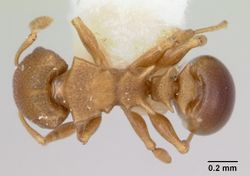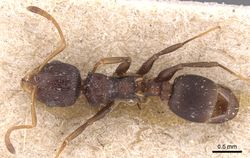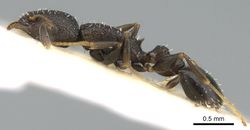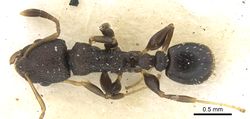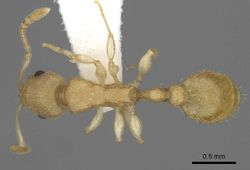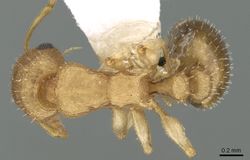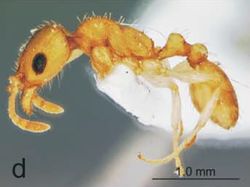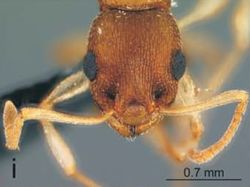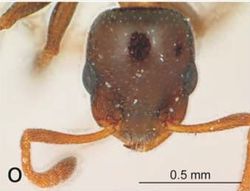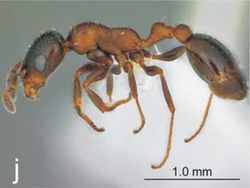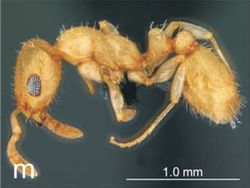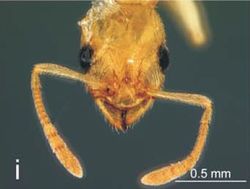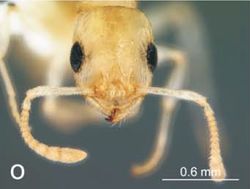Key to Afrotropical Nesomyrmex
This key covers all Afrotrpical species decribed and is based in this references:
- Hita garcia et al (2017)[1] revises the genus for the Afrotropical region, defining four species groups and revising the angulatus group.
- The South African species were revised by Mbanyana & Robertson(2008)[2] revises the South African species, including all the species belonging to the simoni group
You may also be interested in
- Nesomyrmex
- Key to Nesomyrmex species groups of the Afrotropical region
- Diagnosis of Nesomyrmex species groups of the Afrotropical and Malagasy regions
1
- Antennae with 11 segments; petiolar node and postpetiole with conspicuous and very well developed lateral spines ..... N. cataulacoides group (1 species)
- Antennae with 12 segments; petiolar node and postpetiole never with conspicuous and very well developed lateral spines as above, at most petiolar node with small, lateral denticles . . . . . 2
2
return to couplet #1
- Anterior clypeal lobe short, flat-margined, and never convex, lobe with a small median triangular projection; pronotum anterodorsally sharply marginate, with sharp, dentate corners; petiole barrel-shaped with very weakly developed, short and triangular petiolar node ..... N. humerosus group (1 species)
- Anterior clypeal lobe always conspicuously developed, usually convex and variably rounded, sometimes flat, but never with a small median triangular projection; pronotum anterodorsally either rounded or weakly marginate but without sharp, dentate corners; petiole variably shaped, but never as above, usually with very well developed petiolar node. . . . . 3
3
return to couplet #2
- Propodeal spines present and conspicuous, usually long and narrow, in profile distinctly longer than their basal width; hairs on dorsum of mesosoma always present, short, and blunt .....N. angulatus group (4)
- Propodeal spines usually absent, if present, then very short and broad, in profile no longer than their basal width; hairs on dorsum of mesosoma variably developed: usually long, fine and acute, sometimes absent, and only very rarely short and blunt .....N. simoni group (10)
4
angulatus group
return to couplet #3
- In profile mesosomal dorsum forming a single, uninterrupted flat surface without any trace of metanotal groove; petiolar peduncle short . . . . . 5
- In profile mesosomal dorsum always with conspicuously impressed metanotal groove; petiolar peduncle long . . . . . 6
5
return to couplet #4
- Body colour yellow to very light brown .....Nesomyrmex angulatus
- Body colour very dark brown to black .....Nesomyrmex grisoni
6
return to couplet #4
- First gastral tergite lacking standing hairs except for single transverse row on posterior end of tergite Nesomyrmex evelynae
- First gastral tergite with standing hairs evenly distributed throughout . . . . . 7
7
return to couplet #6
- Antennal scapes conspicuously longer (SI 95–98); in dorsal view sides of petiolar node straight to weakly rounded, not laterally denticulate; dorsum of propodeum without standing hairs ..... Nesomyrmex inhaca
- Antennal scapes conspicuously shorter (SI 67–77); in dorsal view petiolar node laterally denticulate; dorsum of propodeum with short standing hairs . . . . . 8
8
return to couplet #7
- Eyes larger, with 10–12 ommatidia in longest row; subpetiolar process with a conspicuous tooth anteriorly, followed by a long cuticular flange running back to the postpetiolar junction Nesomyrmex denticulatus
- Eyes smaller, with 7–9 ommatidia in longest row; subpetiolar process with or without a conspicuously developed tooth anteriorly, but without a long cuticular flange running back to the postpetiolar junction . . . . . 9
9
return to couplet #8
- Propodeal spines shorter and thicker, elongate-triangular and only weakly longer than their basal width; in profile petiolar node nodiform, appearing approximately as long as high .....Nesomyrmex innocens
- Propodeal spines longer and thinner, several times longer than their basal width; in profile petiolar node high, rectangular nodiform, appearing around twice as high as long .....Nesomyrmex stramineus
10
return to couplet #3
- Dorsum of petiolar node rugo-reticulate. Rugoreticulate sculpture is usually also evident partially or completely on head and mesosoma . . . . . 11
- Rugo-reticulate sculpture absent from head, mesosoma and petiolar node. These surfaces either smooth, with longitudinal striations, with transverse rugulae or with fine reticulate sculpture . . . . . 16
11
return to couplet #10
- Propodeum unarmed. Mesosoma, petiolar node and postpetiole rufous coloured, contrasting with black head and gaster. Larger species . . . . . Nesomyrmex braunsi
- Propodeum armed with a pair of short spines or teeth. Uniformly coloured with no obviously contrasting body parts. Smaller species (HW < 1.00) . . . . . 12
12
return to couplet #11
- Erect hairs absent on propodeum . . . . . Nesomyrmex simoni
- Erect hairs present on propodeum – at least four pairs . . . . . 13
13
return to couplet #12
- Black to dark brown. Strongly-developed rugoreticulate sculpture on dorsum of head with reticulate cells sharply defined and large – no more than 16 in any one row counted between the eyes . . . . . Nesomyrmex saasveldensis
- Yellow to medium brown species. Rugo-reticulate sculpture on head present or absent. If present, weakly developed with small reticulate cells between eyes not all clearly distinguishable and total more than 20 in any one row . . . . . 14
14
return to couplet #13
- Anterior clypeal margin only slightly concave laterally, so that the median portion is not clearly defined from the lateral portions. Smaller (HL 0.813–0.902; PW 0.443–0.492) . . . . . Nesomyrmex koebergensis (in part)
- Anterior clypeal margin strongly concave laterally so that the median portion is clearly defined from the lateral portions and appears as a shelf over the mandibles. Larger (HL 0.993–1.101; PW 0.577– 0.680) . . . . . 15
15
return to couplet #1
- Dorsum of head entirely covered by longitudinal rugulae. Propodeum armed with broad triangular teeth, the angle formed by each tooth being nearly 90 degrees. Head narrower (CI 74–79) and scapes relatively longer (SI 101–107) . . . . . Nesomyrmex antoinetteae
- Median portion of head dorsum not covered by longitudinal rugulae, only smooth or with reticulate ground sculpture. Propodeum armed with acute spines, the angle formed by each tooth being much less than 90 degrees. Head broader (CI 83–84) and scapes relatively shorter (SI 87–88) . . . . . Nesomyrmex mcgregori
16
return to couplet #10
- Propodeum unarmed and in profile rounding smoothly from dorsum into declivity, not at all angulate. Declivity without a lateral margin . . . . . 11
- Propodeum armed with a pair of short spines or small triangular teeth or in profile angulate (sometimes very slightly) between dorsum and declivity. If propodeum is angulate, then declivity with a lateral margin . . . . . 22
17
return to couplet #16
- Propodeum without erect hairs . . . . . 18
- Propodeum with erect hairs . . . . . 21
18
return to couplet #17
- Promesonotum without erect hairs. Propodeum hump-shaped and colour brick red, with gaster dark brown . . . . . Nesomyrmex larsenae
- Promesonotum with erect hairs. Propodeum forming an even convexity and colour uniformly light brown . . . . . 19
19
return to couplet #18
- Sides of petiolar node completely covered with strong, sometimes irregular, rugulae. In dorsal view the entire node with continuous rugulae around it. Large species (HW 0.644–0.690) . . . . . Nesomyrmex ruani
- Sides of petiolar node with punctulate ground sculpture or at most with a few weak rugulae. In dorsal view these feeble rugulae may persist, may fade out, or may be replaced entirely with reticulate-punctate sculpture but in no case does the entire node appear to be encircled with strong rugulae everywhere. Small species (HW 0.497–0.590) . . . . . 20
20
return to couplet #19
- In dorsal view, metanotal groove clearly defined and with short longitudinal rugulae . . . . . Nesomyrmex entabeni
- In dorsal view, promesonotum and propodeum confluent with no metanotal groove visible medially . . . . . Nesomyrmex nanniae
21
return to couplet #17
- In profile, posterior and anterior faces of petiolar node with similar slopes. Colour: head and gaster dark brown, with mesosoma and nodes light brown . . . . . Nesomyrmex vannoorti
- In profile, posterior face of petiolar node nearly vertical and much steeper than anterior face. Colour uniformly yellow . . . . . Nesomyrmex njengelanga (in part)
22
return to couplet #16
- Metapleural gland bulla large and bulging – in dorsal view the sides below the propodeum are convex along their medial length. Colour uniformly dark brown . . . . . Nesomyrmex tshiguvhoae
- Metapleural gland bulla not as prominent – in dorsal view the sides below the propodeum are more-or-less straight along their medial length. Colour uniformly yellow or light brown . . . . . 23
23
return to couplet #22
- Petiolar node in profile with angulate anterodorsal and posterodorsal angles and with a flat dorsum . . . . . Nesomyrmex karooensis
- Petiolar node in profile with a rounded posterodorsal angle; anterodorsal angle either angulate or rounded; dorsum convex and not clearly defined . . . . . 24
24
return to couplet #23
- Dorsum of head mainly smooth and shining, with few longitudinal striations between the eyes . . . . . Nesomyrmex cederbergensis
- Dorsum of head with reticulate sculpture, sometimes verlaid by longitudinal rugulae . . . . . 25
25
return to couplet #23
- Propodeum angulate but with no clearly defined pair of short triangular teeth. Smaller species (HW 0.507– 0.559) . . . . . 26
- Propodeum armed with a pair of short triangular teeth. Larger species (HW 0.598–0.718) . . . . . 27
26
return to couplet #25
- Long curved hairs present on the ventral surface of head. Promesonotal dorsum with reticulate ground sculpture overlaid by longitudinal rugulae. Eyes with 12 ommatidia in a longest row. Colour medium brown . . . . . Nesomyrmex inye
- Long curved hairs absent from ventral surface of head, only straight hairs present. Promesonotal dorsum with fine reticulate sculpture and short rugulae along the metanotal groove. Eyes with 10–11 ommatidia in a longest row. Colour uniformly yellow . . . . . Nesomyrmex njengelanga (in part)
27
return to couplet #25
- Dorsum of head with reticulate sculpture overlaid by longitudinal rugulae. Yellow to light brown species . . . . . Nesomyrmex koebergensis (in part)
- Dorsum of head predominantly smooth, with fine reticulate ground sculpture. Pale species . . . . . Nesomyrmex ezantsi
References
<references>
- ↑ *Hita Garcia F., Mbanyana N., Audisio T.L. & Alpert G.D. 2017. Taxonomy of the ant genus Nesomyrmex Wheeler (Formicidae, Myrmicinae) in the Afrotropical region, with a review of current species groups and description of a new species of the N. angulatus group from Mozambique. European Journal of Taxonomy 258: 1–31. http://dx.doi.org/10.5852/ejt.2017.258
- ↑ Mbanyana, N. and Robertson, H.G. 2008. Review of the ant genus Nesomyrmex in southern Africa. African Natural History 4: 35-55


